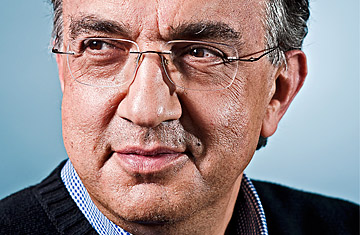
Sergio Marchionn at Chrysler headquarters in Auburn Hills, Mich.
(6 of 7)
To better understand why Fiat took on Chrysler, you also need to look at the auto industry the way carmakers do. The nomenclature they use is alphabetical. Mini cars like the Ford Ka or Toyota Yaris are A class, the subcompact Ford Fiesta is B class, the compact Corolla is C, and so on until you get to E-class luxury cars. Fiat is a small-car and small-engine giant, an A-B-C-D-class specialist, with cars like the Uno, which has been essential to its growth in developing countries like Brazil.
Chrysler is more of a D-E-M-J-class company, with M and J standing for minivans like Town & Country and SUVs like Jeep. They require V-6 and V-8 power, which has been provided by Chrysler's durable Pentastar and Hemi engines.
The combined strengths of the two companies lower costs and improve quality. In the C- and D-class segments, for instance, they will be able to reduce the number of platforms from eight to two. Less is more in manufacturing. Fiat is a leader in small displacement engines like the 1.4-L fully integrated robotized engine that gives the 500 model some real oomph. But some of that technology can be transferred to the revered Pentastar V-6, making it more powerful yet more efficient. The power gains will let Chrysler eliminate six other V-6 engines. Fiat is also miles ahead of Chrysler in diesel and alternative fuels too.
Then there's the increasing number of shared parts, which Marchionne figures will yield nearly $3 billion in savings by 2014 as the companies increase the number of shared suppliers and decrease unit costs.
A Little Italian Love
When fiat took charge of the Jefferson North assembly plant, one of the last auto-assembly lines left in Detroit, it was a wreck: the roof leaked, bathrooms were falling apart, and one shift had been idled as then owner Cerberus fought desperately to merely survive. Rather than close the plant for renovation, Fiat paid assembly workers to rebuild it. They painted, made repairs and reconfigured all the conveyance systems. Fiat made lots of cosmetic changes too, installing new locker rooms and an atrium break area.
More important, Fiat sent over some two dozen workers from its Pomigliano plant in southern Italy to teach its World Class Manufacturing program. Rather than bringing in squads of industrial engineers to dictate the exact sequence of each assembly process, workers were trained to use analytical tools to help them understand each process in the 400 or so workstations on the floor--for example, what's the most efficient and most ergonomic way of tightening a seat bolt.
The emphasis is on safety and increased knowledge, which boosts productivity because workers, not engineers, own the quality-control process. "The people are much more proactive. You don't see the hierarchy typical of manufacturing, [so] we had very, very strong support from the UAW," says Stefan Ketter, global manufacturing boss for Fiat and Chrysler. Team leaders now take part in warranty-analysis meetings, where Marchionne is known to show up unannounced.
